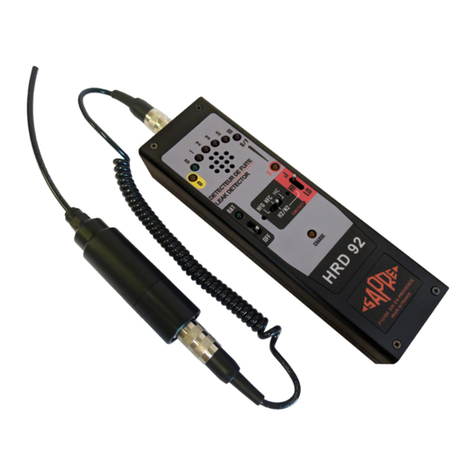
MULTI GAS LEAK DETECTOR
ME-LOKATOR VL30 –REFRIGERANT GASES PAGE | 1
TABLE OF CONTENTS
1INTRODUCTION ..............................................................................................................................................................................................2
2GENERAL SAFETY INSTRUCTIONS.............................................................................................................................................................2
3DESCRIPTION OF THE APPLIANCE .............................................................................................................................................................3
3.1 FUNCTIONALITIES.................................................................................................................................................................................3
3.2 DETECTOR MODULES ..........................................................................................................................................................................3
3.2.1 FRONT PANEL OF ELECTRONIC UNIT ................................................................................................................................... 4
3.2.2 REAR PANEL OF ELECTRONIC UNIT...................................................................................................................................... 4
3.2.3 LEFT PANEL OF ELECTRONIC UNIT....................................................................................................................................... 4
3.2.4 DUAL CONNECTOR CABLE ..................................................................................................................................................... 4
3.2.5 SUCTION BLOCKS .................................................................................................................................................................... 5
3.2.6 DETECTION CELLS................................................................................................................................................................... 5
4INSTALLATION & START-UP.........................................................................................................................................................................6
4.1 ASSEMBLY .............................................................................................................................................................................................6
4.1.1 ASSEMBLY OF THE SUCTION BLOCK DETECTION CELL.................................................................................................... 6
4.1.2 ASSEMBLING THE SUCTION BLOCK TO THE UNIT .............................................................................................................. 6
4.1.3 CONNECTION TO MAIN POWER ............................................................................................................................................. 6
4.1.4 OPERATION WITH INCORPORATED BATTERIES PACK....................................................................................................... 6
4.2 LOKATOR VL30 FIRST START .............................................................................................................................................................7
4.2.1 VERIFICATIONS BEFORE START-UP...................................................................................................................................... 7
4.2.2 START-UP .................................................................................................................................................................................. 7
4.2.3 STARTING SEQUENCE............................................................................................................................................................. 7
5USE OF LOKATOR VL30................................................................................................................................................................................8
5.1 PRECAUTIONS OF USE ........................................................................................................................................................................8
5.2 DETECTION INTERFACE.......................................................................................................................................................................8
5.2.1 DETECTION LIGHT RAMP and SOUND SIGNAL..................................................................................................................... 8
5.2.2 DETECTION SCREEN ............................................................................................................................................................... 9
5.3 LEAK REASEARCH & DETECTION....................................................................................................................................................10
5.3.1 LEAK RESEARCH PROCEDURE............................................................................................................................................ 10
5.3.2 ZEROTTING STABILITY .......................................................................................................................................................... 10
5.3.3 « SATURATION - CONTAMINATION » CONTROLE ............................................................................................................. 10
5.4 CALIBRATION FUNCTION...................................................................................................................................................................11
5.4.1 CHECK OF CALIBRATION ...................................................................................................................................................... 11
5.4.2 PRECAUTIONS TO BE TAKEN BEFORE CALIBRATION PROCEDURE .............................................................................. 11
5.4.3 CALIBRATION PROCEDURE .................................................................................................................................................. 11
5.5 SELF-CHECKING .................................................................................................................................................................................12
6OPTIONS MENU............................................................................................................................................................................................12
6.1 OPTION 1 –PROFILE A.......................................................................................................................................................................12
6.1.1 SELECTION OF THE TYPE OF GAS SET TO PROFILE A .................................................................................................... 12
6.1.2 SELECTION OF THE THRESHOLD SET TO PROFILE A ...................................................................................................... 12
6.2 OPTION 2 –PROFILE B.......................................................................................................................................................................12
6.2.1 SELECTION OF THE TYPE OF GAS SET TO PROFILE B .................................................................................................... 13
6.2.2 SELECTION OF THE THRESHOLD SET TO PROFILE B ...................................................................................................... 13
6.3 OPTION 3 ..............................................................................................................................................................................................13
6.3.1 CURRENT UNIT ....................................................................................................................................................................... 13
6.3.2 LANGUAGE SETTING.............................................................................................................................................................. 13
6.4 OPTION 4 ..............................................................................................................................................................................................13
6.4.1 FAST DEGASSING OPTION.................................................................................................................................................... 13
6.4.2 AUTO-START OPTION ............................................................................................................................................................ 13
6.4.3 RESET –FACTORY SETTING ................................................................................................................................................ 13
7ERROR & FAULT MESSAGES.....................................................................................................................................................................14
8MAINTENANCE - WARRANTY.....................................................................................................................................................................15
8.1 REPLACING THE DETECTION CELL .................................................................................................................................................15
8.2 CAP AND FILTERS...............................................................................................................................................................................15
8.3 PERIODIC CONTROL...........................................................................................................................................................................15
8.4 WARRANTY ..........................................................................................................................................................................................15
9DISPOSAL .....................................................................................................................................................................................................15
10 CE DECLARATION........................................................................................................................................................................................16
11 TECHNICAL DATA........................................................................................................................................................................................17




























